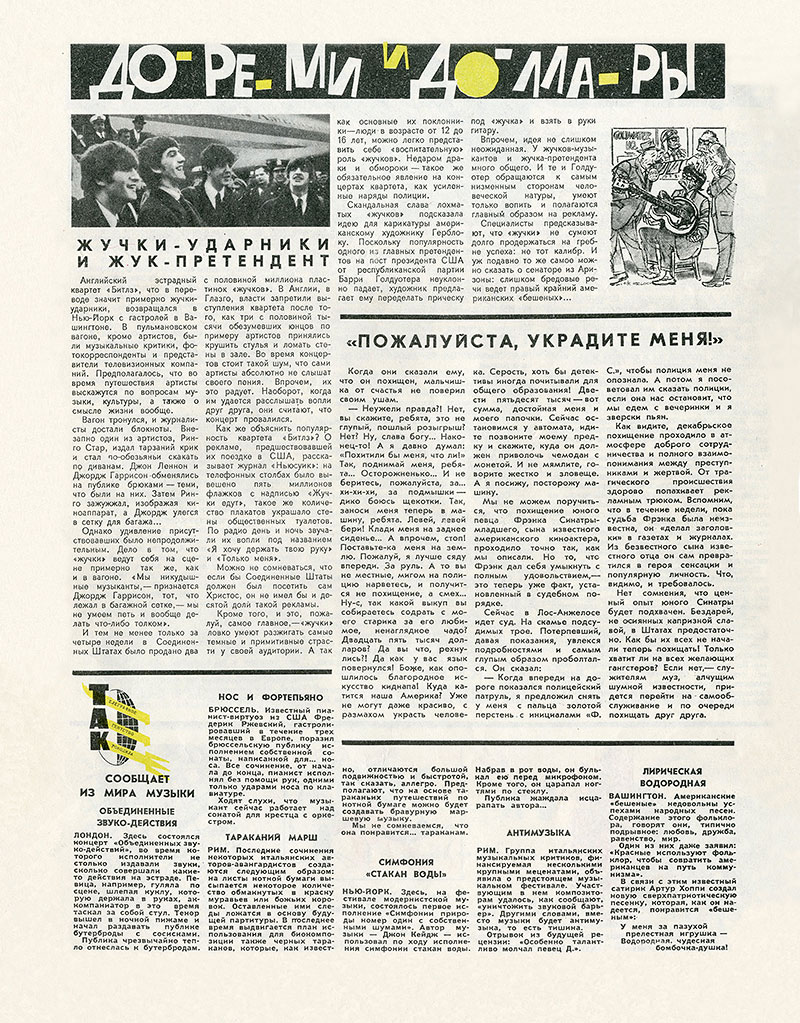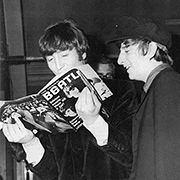Последнее обновление 17 июня 2015 года
ЖУЧКИ-УДАРНИКИ И ЖУК-ПРЕТЕНДЕНТ
журнал Крокодил, 1964, № 8 (1730), 20 марта, стр. 10, ил.
В этой статье Джордж Харрисон представлен под фамилией Гаррисон, а Ринго Старр – под фамилией Стар.

Страница 10
[Для увеличения статьи, кликните на изображение, затем на синий квадрат в правом нижнем углу]
Примечание
Найден перевод этой статьи на английский язык, сделанный одним бывшим нашим соотечественником, ныне живущим в США:
|
BEETLES-DRUMMERS AND BEATLE THE CANDIDATE
British quartet The Beatles which can be approximately translated as the beetles-drummers, was returning to New York from a tour in Washington. A Pullman car carrying the artists was also filled with music critics, photographers and TV correspondents. During the train trip the artists were expected to discuss their views on music, culture and the meaning of life in general.
The train started moving and the journalists got their notepads ready. Suddenly one of the artists, Ringo Star yelled like a Tarzan and started jumping on the couches like an ape. John Lennon and George Garrison traded pants in public, the ones they were wearing at the time. Then Ringo made the buzzing noises sounding like a film camera, and George climbed on the luggage rack.
But those present in the car weren't amused for long. The thing is that the "beetles" behave on the stage just like they were acting on the train. "We are worthless musicians" admits George Garrison, the one lying in the luggage rack, "we can't sing or do anything else with any skill."
Nevertheless, in only four weeks two and a half million records by the "beetles" were sold in the USA. In Glasgow, England the performance by the quartet was banned after three and a half thousand crazed youths started crashing chairs and walls following the example of the artists. The noise during the concerts is so loud that the artists can't hear their own singing. This actually makes them happy. Just the opposite, when they can hear each other's screams they feel that the concert was a failure.
How can one explain the popularity of the quartet "The Beatles"? Even the magazine Newsweek mentions the ad campaign preceding their visit to the US: five million banners with the words "The Beatles are coming" were hanged on the telephone poles; the same number of posters was decorating public restrooms. Their screams named "I Want To Hold Your Hand" and "Love Me Do" were played on the radio day and night.
There is no doubt that if Christ himself visited the United States, he wouldn't get even a tenth of the advertisement.
Most importantly, "beetles" are masters at stirring up the darkest and the most primitive emotions in their audiences. And since most of their fans are between 12 and 16 years old, it's easy to imagine the "educational" influences of the "beetles". It only makes sense that fights and fainting are just as an inseparable part of the quartet's concerts as the reinforced police presence.
Scandalous fame of the hairy "beetles" gave an idea to an American cartoonist Herblock. Since the popularity of one of the leading candidates for the President of the USA from the Republican Party Barry Goldwater is steadily declining, the artist suggested he should a get a "beetle"-like haircut and pick up a guitar.
Although this idea is not that outrageous; beetles – musicians and beetle-candidate have a lot in common. They both appeal to the lowest in human nature, they only know how to scream and mainly rely on the advertisement.
Specialists predict that "beetles" won't be able to hold on to their success, they are just not in the league. And the same can be said about the senator from Arizona: his speeches are too delusional even for the right-wing of the American "crazies"...
Note from the translator: the article uses the wordplay Beatles-beetles mostly referring to The Beatles pejoratively as bugs.
|
| Дополнительная информация об издании |
 |


